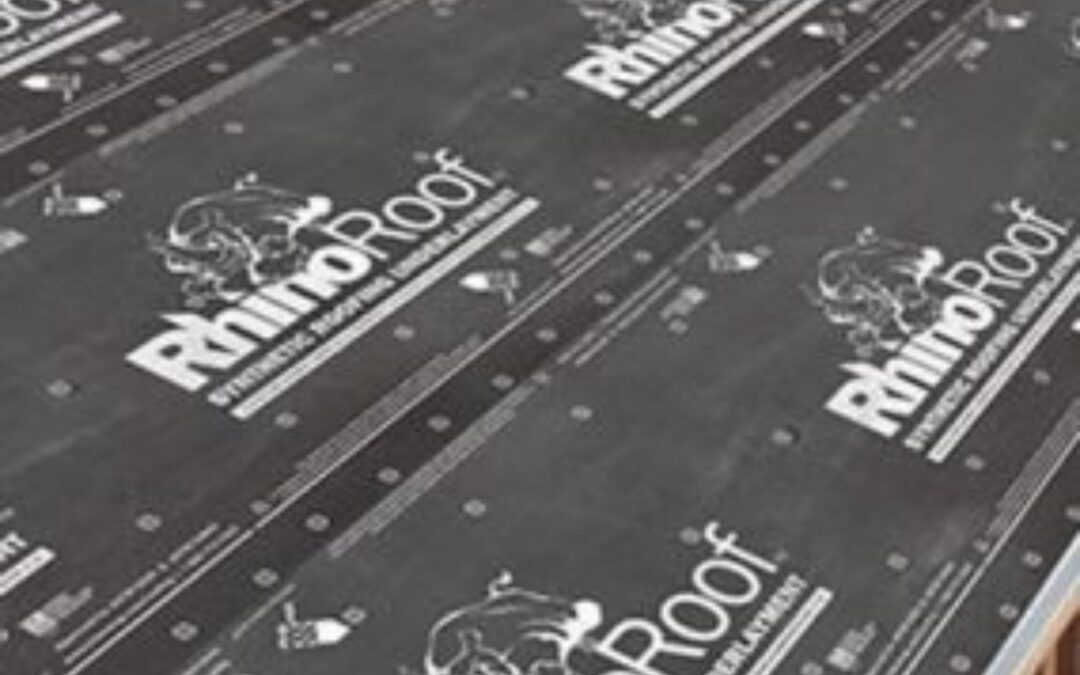Well, this depends. Other than gutters and shingles, rhino roof underlayment is something to consider during roof installation.
Most individuals are ignorant that an extra layer exists between the shingles and rooftop deck, which aids in the prevention of water damage to structures. Rhino roof synthetic underlayment is a crucial component of any roof installation.
There are two different types of underlayment – rhino roof synthetic underlayment and felt.
What Is Roof Underlayment?
Roofing underlay is a watertight or water-resistant substance that is applied directly to the rooftop deck before the installation of any additional roof shingles.
It provides a barrier between your house and the rooftop deck, protecting it from leakage and the impacts of adverse weather.
What Are The Different Kinds Of Roofing Underlayment?
Roofing underlayment is classified into two types which are Felt underlayment and Synthetic Underlayment.
Each type has benefits and disadvantages, and the type of roofing underlayment such as rhino roof synthetic underlayment you pick.
Will be determined by your roof design, geographical location, price, roofing materials utilized, and what a professional roofing contractor recommends.
What Exactly Is Felt Roof Underlayment?
Felt underlayment is one of the most common Roofing Underlayments. Saturating fiberglass mat or paper with asphalt is how felt underlayment is made.
No.15 felt or No. 30 felt are the two forms of Felt roofing underlayment.
The difference is that No. 30 felt underlayment is thicker, harder, and will be less vulnerable to ripping or tearing when being installed or owing to extreme weather conditions.
What Exactly Is Synthetic Underlayment?
Many people prefer synthetic underlayment for much-improved waterproofing and shielding from harsh weather. Synthetic underlayments are often composed of polymers for the durability of underlayment.
The synthetic underlayment is water-resistant, when installed appropriately, synthetic underlayment outperforms felt underlayment in terms of weather protection.
Because synthetic underlayment substances are not regulated, producers may produce their products independently, as a result differing degrees of efficacy
Synthetic Underlayment Vs. Felt Underlayment
When selecting underlayment for your roof, consider the product’s weight, pricing, and other factors. Let’s look at the differences between felt and synthetic underlayment.
Benefits Of Felt Roof Underlay
The biggest advantage of employing felt underlayment is its low cost.
Felt underlayment is typically less expensive than synthetic underlayment, making it the preferred choice for cost-conscious homeowners.
The Disadvantages
The use of a felt underlayment on your roof has various drawbacks. Felt underlayment always has the disadvantage of not being able to be left uncovered for longer than a few hours.
Heat may cause the material to leach oils or dry out. These would affect the felt’s capacity to repel water.
Other Drawbacks Of Felt Underlay Include
In severe wind as well as during installation, this fabric is vulnerable to tearing.
If it is exposed to moisture, it might absorb moisture and the felt will be wrinkled, making it extremely difficult to arrange the shingles evenly.
To offer maximum protection, shingles should be put promptly after the felt underlayment.
The felt underlayment is also heavier, which might make installation more challenging.
The Advantages Of Synthetic Underlayment
Installing synthetic underlayment instead of felt has several major advantages. Synthetic underlayment is more cost-effective than felt.
- Sustainable
- Installs quickly
- Safe
- Water-repelling
In comparison to the felt underlayment, the synthetic underlayment is quite robust and durable.
Rhino roof synthetic underlayment made of synthetic materials is highly long-lasting.
It doesn’t usually rip and, in certain situations, may withstand lengthy Exposure to UV radiation and humidity, which is particularly important if the roof cover isn’t placed for a while.
As a result, the greatest option you can make is to use rhino roof synthetic underlayment.
The Durability Of Roof Synthetic Underlayment
When installing a new roof, you want it to withstand the weather and survive for many years. Taking this into account, synthetic underlayment outlasts felt underlayment.
Felt underlayment is far more likely to tear in strong winds as well as during placement. In addition, synthetic underlayment retains nails well and resists water rather than absorbing the water
When felt underlayment comes into contact with water or moisture, it absorbs it and causes the felt to be wrinkled. As a result, shingles must be put in immediately after the felt is installed.
One thing to remember from this is that rhino roof synthetic underlayment will strengthen and will better protect the roof from harsh weather.
Fast Installation
Since synthetic underlayment has much more substance per roll when compared to felt underlayment and comes in longer and wider rolls, your contractors will run around less, which helps to save time and possibly hurry up the work.
Safe
Most synthetic underpayments include a variety of textures that are resistant to slip for improved walkability.
It’s typically marked well with overlapping guides and fastening placement indications, which aids in uniformity and accuracy during installation.
Water-Resistant
Unlike felt products, synthetic roofing underpayments are engineered to resist water. This is especially important for homeowners who are afraid of moisture penetration.
Because it is made of plastic, synthetic underlay, unlike felt underpayments, is typically resistant to the growth of mold.
Disadvantages Of Synthetic Underlayment
Synthetic underlayment is more expensive than felt. Investing in quality underlayment materials upfront, on the other hand, could end up saving your money over the long term.
The sense of security that comes from knowing that your roofing is protected from moisture cannot be overstated.
The Best Roofing Underlayment
Before selecting an underlayment, there are many various factors to consider.
The benefits of synthetic underlayment over felt are numerous, and it could be a smart investment to shield the roof of your house from the hazards of water and harsh weather.
As a result, synthetic underlayment is preferable to felt underlayment, which is why rhino roof synthetic underlayment is the finest option.
Contact Us
If you are shopping for rhino roof underlayment, please contact SYL Roofing Supply. We are eager to assist you.

